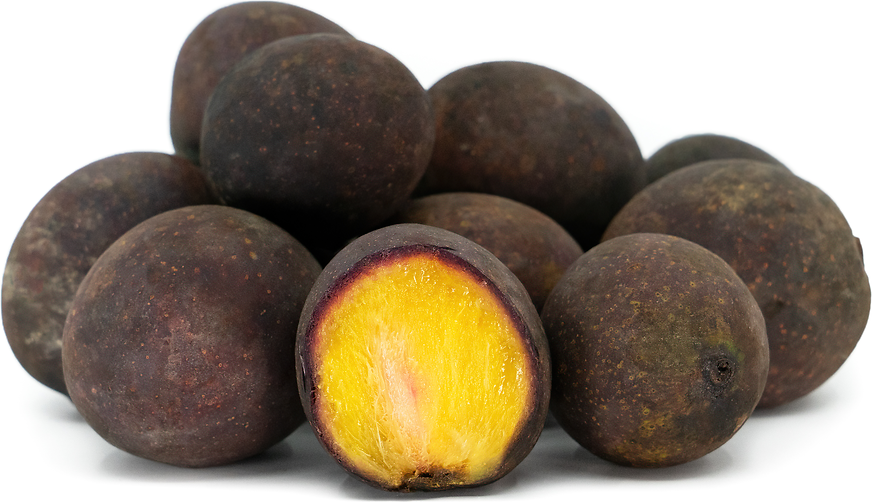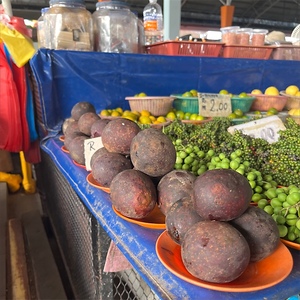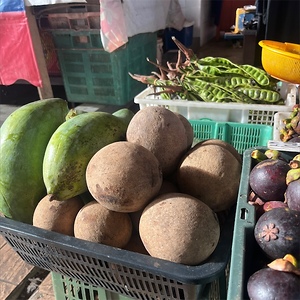


Asam Kumbang Fruit
Estimated Inventory, lb : 0
Description/Taste
Asam Kumbang fruits are oval-shaped and can vary in size, generally measuring around 7 centimeters wide. Their skin transitions from a dark green hue to a deeper, dark purple-brown and is spotted with yellow lenticels. The outside of the fruit appears slightly dusted with a faint white residue and has occasional dark patches. There is a small apex at the bottom of the fruit where it was once attached to the Asam Kumbang tree. This variety has bright, orange-yellow flesh that’s extremely juicy and fibrous, similar to that of a mango. Their flesh is firm yet succulent, releasing moisture when bitten into, and has a glossy look compared to the matte, dusty skin of the fruit. The center of Asam Kumbang fruits contains a large, hard, and inedible red seed. This aromatic variety emits fragrances of plum and prune. Their flavors also have a hint of prune along with a distinctly sweet and sour taste and acidic undertones.
Seasons/Availability
Asam Kumbang fruits are available from late spring to early summer and late fall to early winter.
Current Facts
Asam Kumbang fruit are botanically classified as Mangifera quadrifida and are from the Anacardiaceae family. They are a type of wild mango that has served various culinary and medicinal purposes for centuries. The word asam means sour in Malay, while the word kumbang means beetle. In Chinese, the Asam Kumbang fruit is also known as Heipuisan, which means black-skinned mango. This variety is named after the city of Asam Kumbang, Malaysia, and is also referred to as Asam Putarum, Sepam, Lekub, Damaran, Rancha-rancha, Asam Rawawa, Rawa-Rawa, Ubab, and Balangan. They are one of 25 wild mango species grown in Southeast Asia and are at risk of extinction because of deforestation. The Asam Kumbang fruit tree is harvested for both fruit and wood, the latter of which is used for construction, flooring, interior paneling, and decor.
Nutritional Value
Asam Kumbang fruits are rich in vitamins C and A, encouraging immune function, skin and vision health, collagen production, cell development, and protection against free radical cell damage. This variety is a source of iron, a nutrient that helps produce red blood cells, prevent anemia, and increase energy levels. They provide the body with potassium to regulate electrolyte balance, muscle function, blood pressure, and counteract the effects of sodium. Asam Kumbang fruits contain magnesium, a vital mineral that promotes sleep, healthy blood sugar levels, digestion, and nerve, heart, and bone health.
Applications
Asam Kumbang fruits are primarily consumed fresh or pickled. To eat them, make an incision on the skin with a knife and peel back the outer flesh. The juicy flesh can be sucked off the inner seed, much like a mango. In Malaysia, this variety is frequently consumed with salt, anchovies, garlic, sugar, and sambal belacan, a condiment made from lime juice, chilies, and shrimp sauce. When pickled, these fruits are commonly eaten with rice dishes. Asam Kumbang fruits add a sour touch to curries, soups, smoothies, ceviche, poke bowls, stir-fries, and fish dishes. They pair well with yogurt, granola, coconut, pineapple, papaya, strawberries, salad greens, cucumber, cashews, and chia seeds. Store Asam Kumbang fruit in the refrigerator, where they will last up to a week.
Ethnic/Cultural Info
One of the most common places to find Asam Kumbang is in the country of Borneo, the third-largest island in the world. The tropical rainforest of Borneo is one of the oldest and most biodiverse rainforests in the world. It contains Asam Kumbang fruits as well as a variety of other wild mangoes that are also sold in local street markets. The durability, disease resistance, and ability to produce fruit without needing cold temperatures make Asam Kumbang fruits promising for improving existing mango varieties and creating new hybrids. This variety, and other wild mangoes, are at risk of extinction due to climate change and deforestation. Increased conservation efforts to preserve the land and trees where these mangoes grow can help prevent their extinction.
Geography/History
Asam Kumbang fruits are native to Southeast Asia and are commonly grown in Malaysia, Indonesia, Borneo, Brunei, and Singapore. They thrive in hot, tropical areas with plenty of rain and are often found growing along riverbanks, lowland forests, and inundated land. In Southeast Asia, Asam Kumbang fruit trees have been harvested from the wild and grown in traditional longhouses for generations. In 1998, the species was listed as threatened by the World Conservation Monitoring Centre and continues to be at risk of extinction. Asam Kumbang fruits were introduced to other parts of the world, including Florida in 2004, and now also grow in Puerto Rico and Hawaii, but remain rare and are not commonly found outside of street markets in their native regions.










